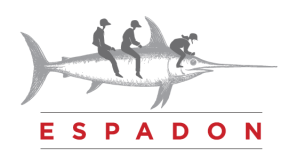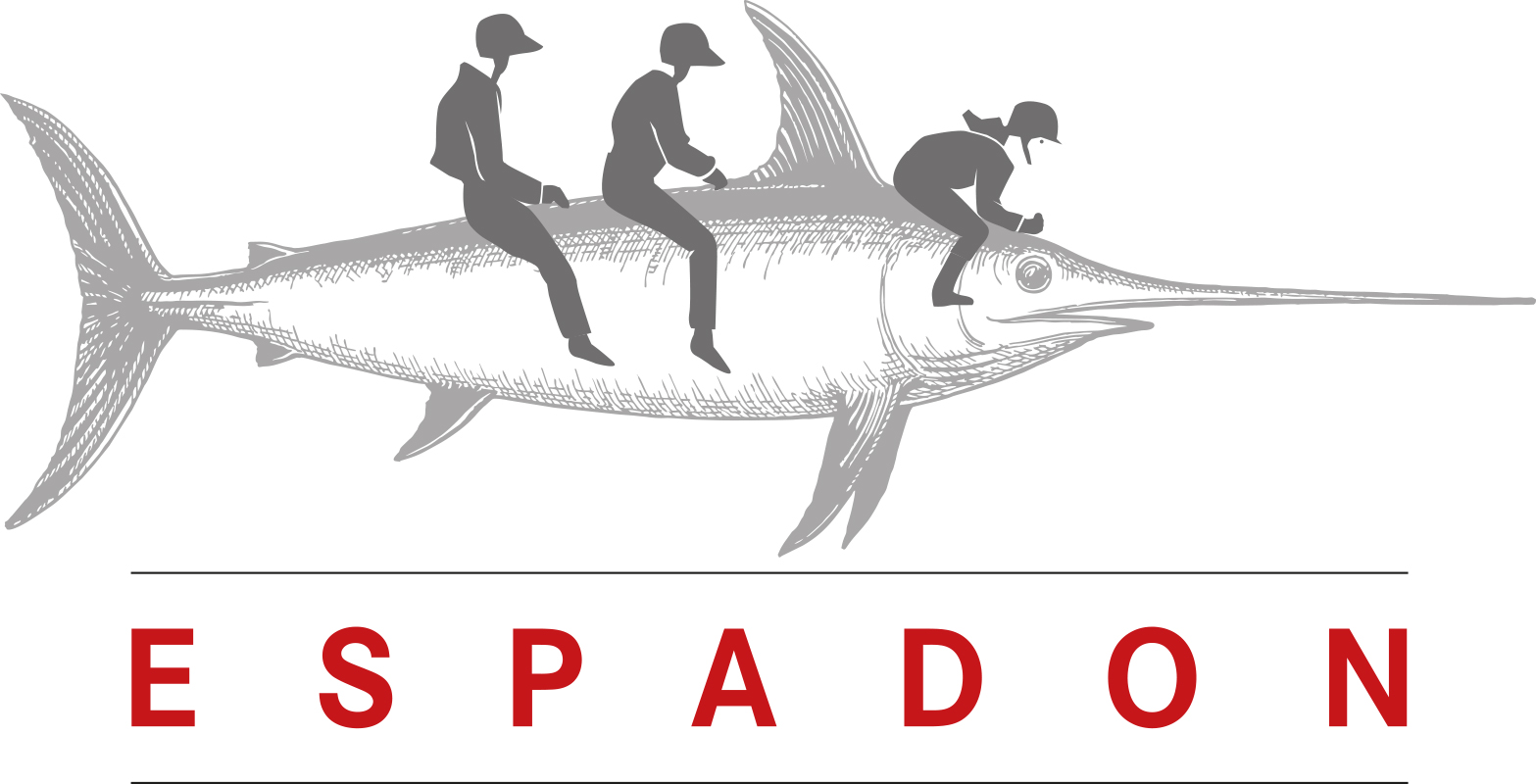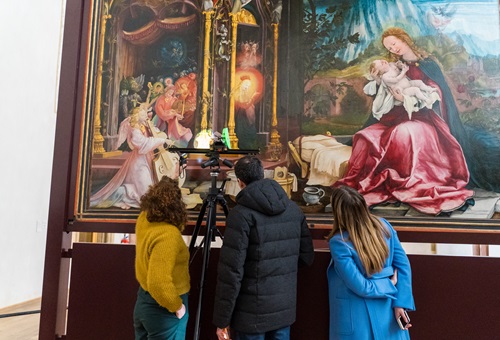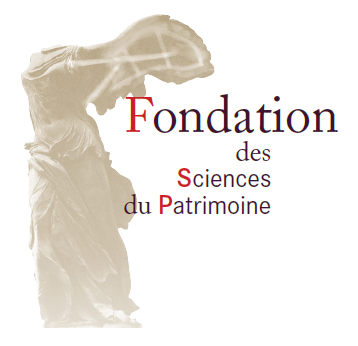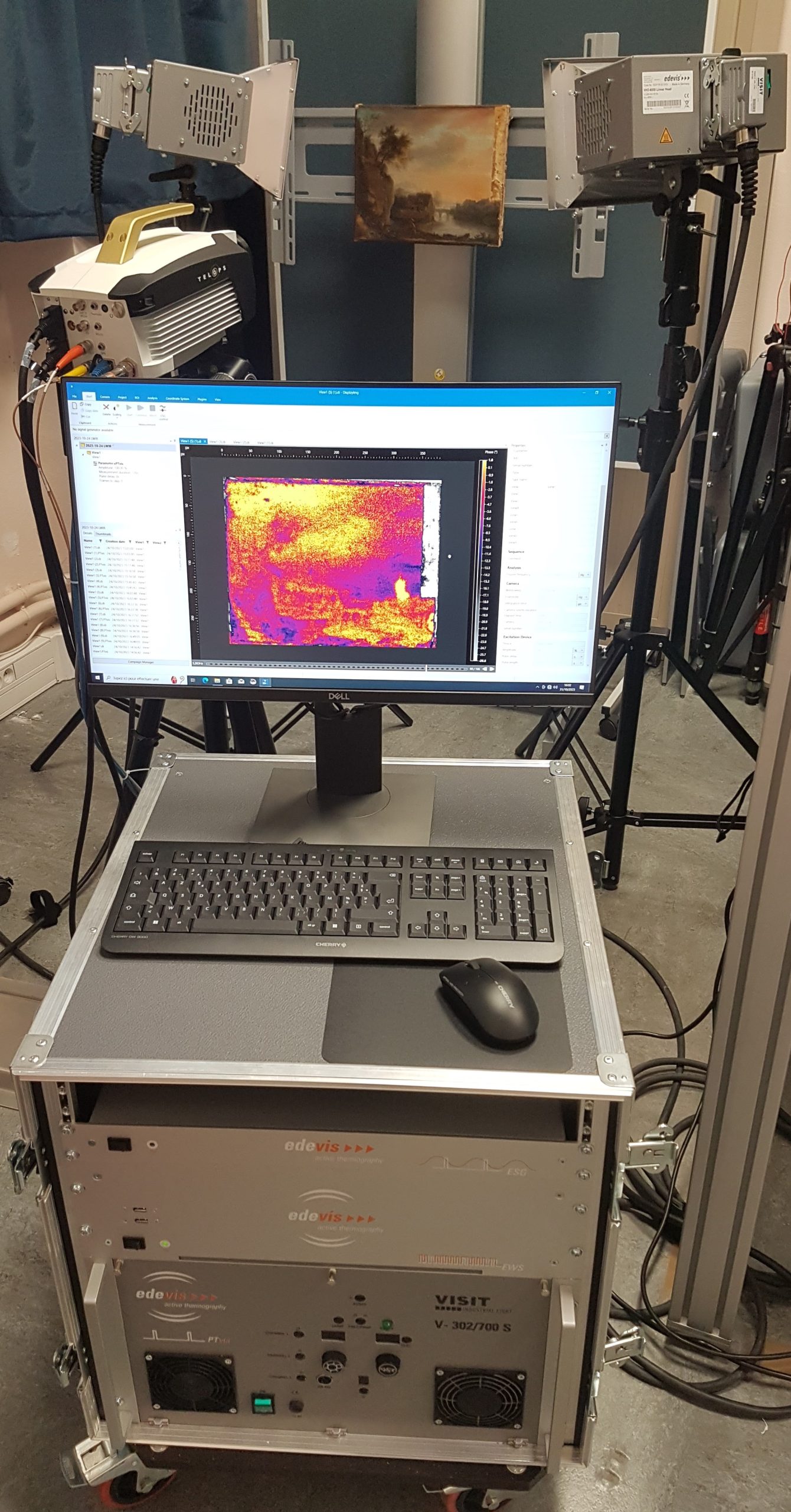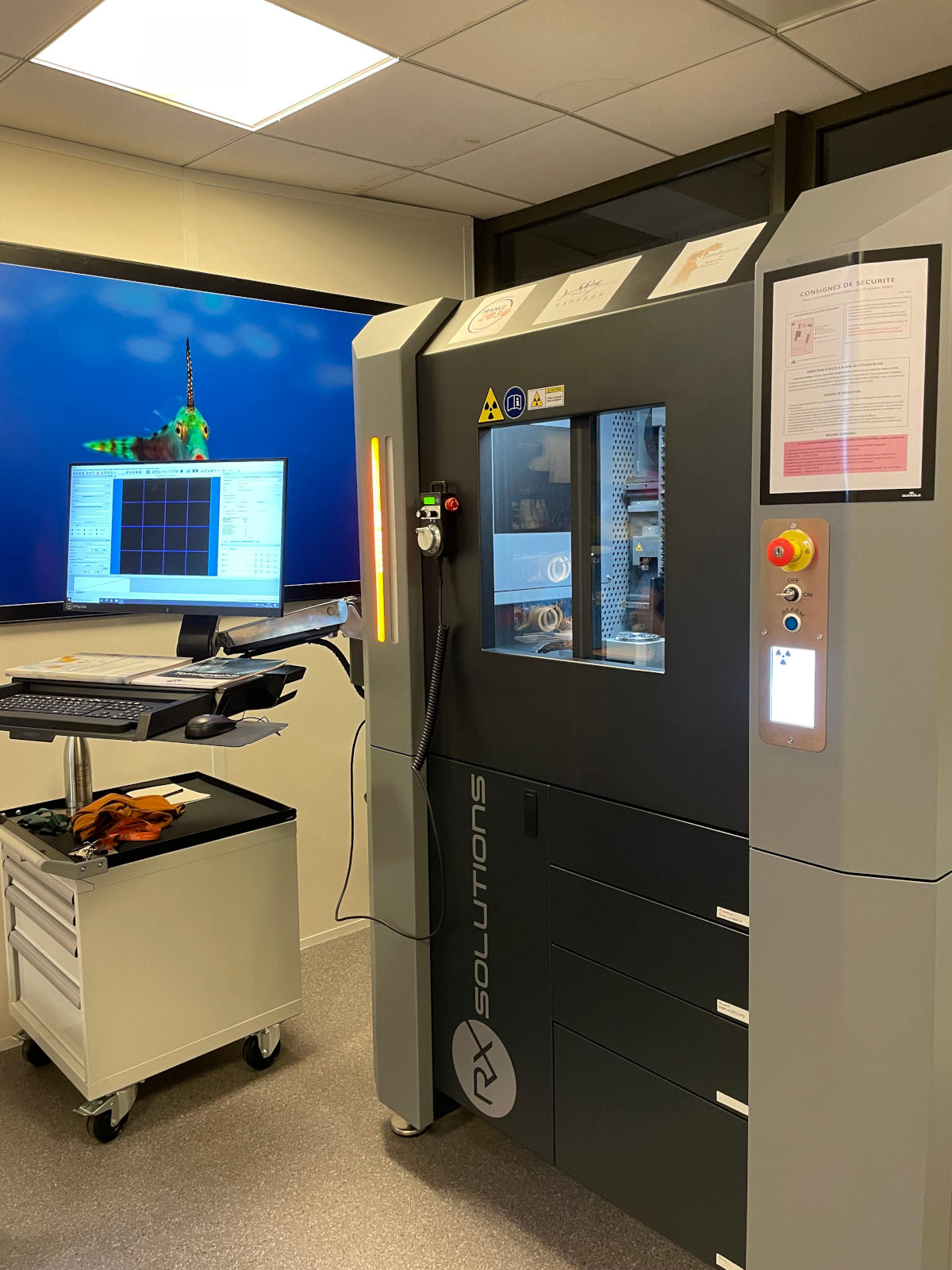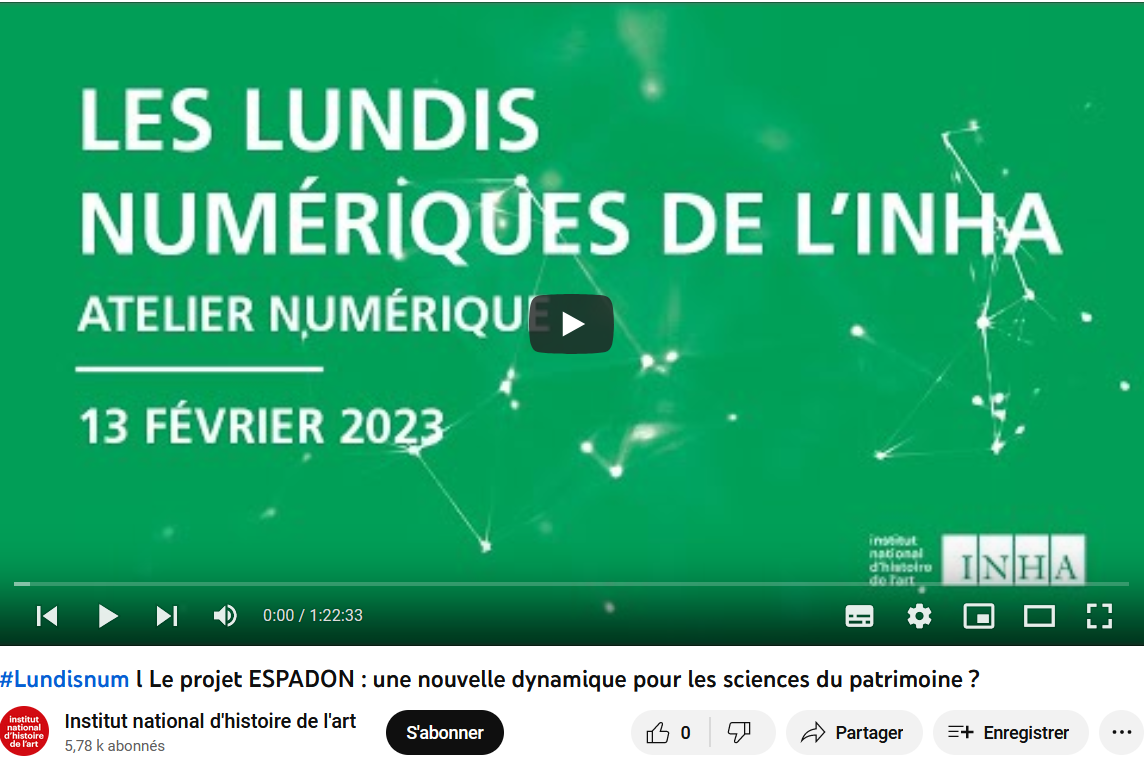- Les laboratoires CRC, LRMH, C2RMF (Culture, CNRS)
- IPANEMA (Culture, MNHN, CNRS, UVSQ)
- La Graduate School « Humanités – Sciences du patrimoine » (UVSQ – Université de Paris Saclay),
- Les laboratoires ETIS, SATIE, HERITAGES (CY – Cergy Paris Université, CNRS),
- Les laboratoires CHCSC, DYPAC, DAVID (UVSQ – Université de Paris Saclay)
- Le laboratoire MAP (CNRS, Culture)
- Le Laboratoire LAPA – Equipe Nimbe (CEA, CNRS)
- Le CICRP (Centre Interdisciplinaire de Conservation et de Restauration du Patrimoine) à Marseille
- La plateforme AST-RX (Muséum National d’Histoire Naturelle, CNRS)
- Le laboratoire LOB (Ecole Polytechnique, CNRS, Inserm).
- L’institut national du patrimoine (INP)
- L’Ecole nationale des Chartes
- Le CEA – Paris-Saclay
- L’Université Paris Nanterre (HAR, Arscan)
(Partenaires associés : l’EHESS, Synchrotron SOLEIL ainsi que l’ensemble des membres de la Fondation des sciences du patrimoine qui est placée sous le haut patronage du Ministère de la culture).
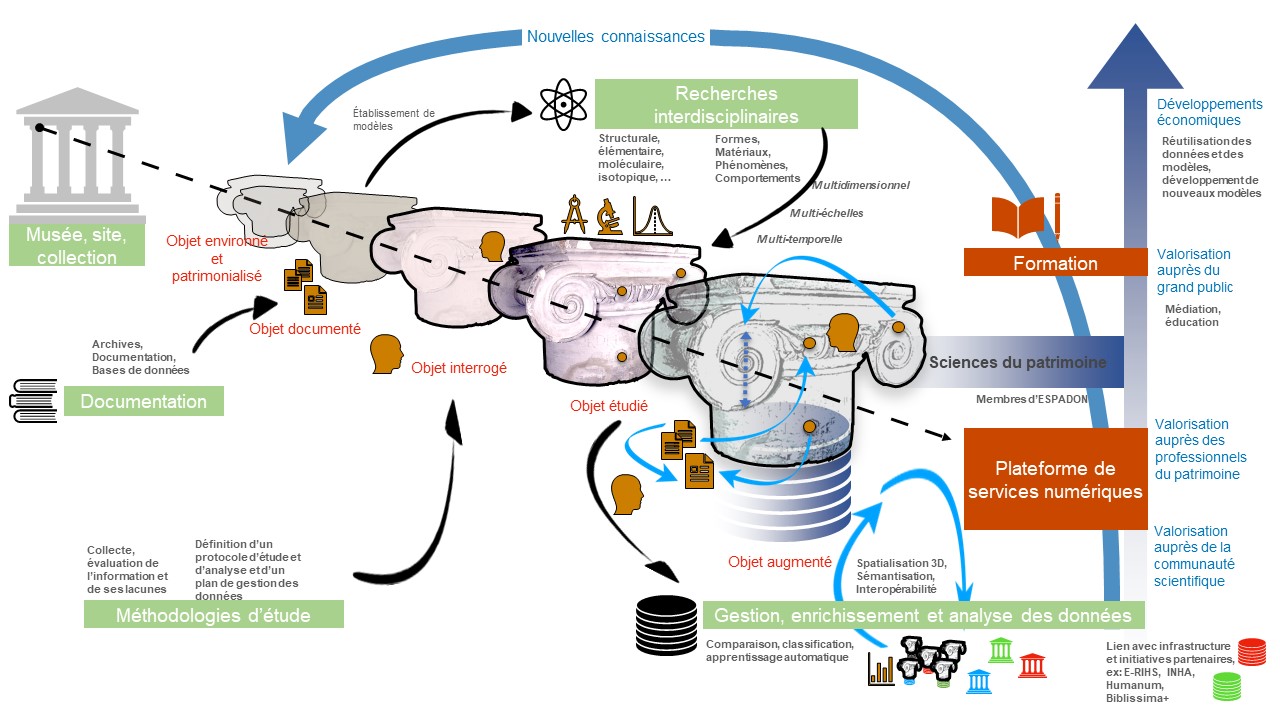
Le premier objectif d’ESPADON est de relever un défi instrumental. La forte évolution enregistrée au cours de la dernière décennie permet désormais d’améliorer la caractérisation d’un objet patrimonial, de l’analyse localisée par échantillonnage d’œuvres d’art ou par des techniques d’analyse ponctuelle, à l’approche analytique en 2D ou 3D. Le temps est venu d’assurer son application aux objets du patrimoine. En outre, en couplant l’instrumentation analytique et structurelle, il est également temps de garantir des capacités multidimensionnelles, multi-échelles et multitemporelles afin d’obtenir une approche multimodale. Cela signifie fusionner des données hétérogènes afin de les traiter et d’en extraire de nouvelles données et de nouvelles informations qui ne sont pas visibles en considérant chaque approche séparément.
L’objectif informationnel est d’augmenter les capacités de traitement des données afin de relever le défi de la gestion et du stockage massif des données. ESPADON devra alors proposer des solutions liées au traitement des données, à leur stockage et à leur échange. Ceci est en cohérence avec la transition numérique qui s’opère dans les différentes institutions et ministères au niveau français. Ces actions permettront de fédérer les communautés académiques et professionnelles en France et seront l’occasion de mettre en place des actions de formation. Au niveau européen, le projet s’inscrit dans la continuité de l’initiative E-RIHS DIGILAB. ESPADON permettra à la communauté des sciences du patrimoine d’améliorer considérablement l’accès à l’information, par exemple via l’exploration de données. L’une des questions clés est l’interopérabilité dans la création de données.
Par rapport à d’autres domaines de recherche, le patrimoine culturel est particulier en raison de la variété (en termes de matériaux, de formes, d’échelle, etc.) des objets étudiés, et de leur unicité. En outre, au niveau institutionnel, les habitudes sont également très diverses. Cela rend plus difficile (mais nécessaire) l’objectif de collecter toutes sortes d’informations ou de connaissances générées autour d’un seul objet du patrimoine tangible. ESPADON mettra en place un écosystème et un modèle numériques pour assurer la représentation et l’accès à ces informations dans un espace de données unique. À cette fin, nous développons le concept d’un modèle d' »objet du patrimoine augmenté ». Basé sur une architecture de stockage distribuée et interopérable, il ne sera pas un simple agrégateur, mais un nouveau média pour la science du patrimoine.
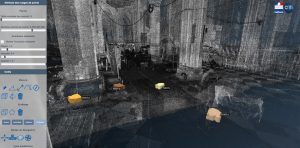
Les « objets du patrimoine » sont très divers, allant des objets de musée aux bâtiments historiques en passant par les sites archéologiques. Leur patrimonialisation implique l’existence d’une documentation connexe forgée par des professionnels de la conservation, mais aussi éventuellement des archives, des rapports scientifiques, des études historiques et d’histoire de l’art, … Compte tenu des lacunes dans cette documentation, l’objet peut être interrogé via diverses méthodologies et être soumis à des recherches (interdisciplinaires) concernant par exemple les phénomènes élémentaires, moléculaires, structurels, la surveillance du changement climatique pour la préservation de l’objet, ou le domaine des sciences humaines, à différentes échelles.
Le défi consistera à trouver le meilleur moyen de fusionner toutes ces données hétérogènes liées à l’objet, de les organiser et de les visualiser. En effet, ESPADON offrira une plateforme de services numériques assurant la numérisation, la sémantisation et l’interopérabilité des données. Une telle plateforme permettra par exemple la comparaison, la classification, l’apprentissage automatique. Il s’agira d’un nouveau média, partagé par la communauté académique des sciences du patrimoine, ainsi que par les professionnels. Les mondes éducatif et socio-économique auront accès à une partie de ces informations, selon les règles des institutions abritant les dépôts de données.
Définition retenue :
OPA (Objet Patrimonial Augmenté) : Écosystème numérique à élaborer en lien étroit avec les acteurs de l’ensemble des communautés scientifiques et professionnelles du champ des Sciences du patrimoine et qui permettra, à terme, d’accéder à tout type d’informations relatives à un objet du patrimoine via une infrastructure distribuée, et de les visualiser grâce à des moyens novateurs.
Gouvernance
Si le projet est porté par la FSP, ESPADON dispose d'une gouvernance propre assurée de manière collégiale autour d'un Comité de Pilotage et d'un Comité de suivi scientifique. En plus de ces instances dédiées, plusieurs représentants d'ESPADON siègent au Comité d'orientation stratégique de la FSP.
Les actions d'ESPADON sont organisées par work packages (groupes de travail) :
• WP1 : Tomographie X Imagerie chimique multi-échelle (François Mirambet)
• WP2 : PIXXL Particle Induced X-rays eXpanded to Large objects ligne d’imagerie PIXE à champ large pour l’accélérateur (Thomas Calligaro)
• WP3 : Groupe de travail « Lumière » L’interaction lumière/matière comme sonde d’analyse (Christine Andraud)
• WP4 : PASTAGA (Patrimoine Architectural, Sites, Territoires Archéologiques et Grands Artéfacts) (David Giovannacci)
• WP 5 : Sciences humaines et sociales (Philippe Jockey)
• WP 6 : Climat/comportement/ Patrimoine (Ann Bourgès)
• WP7 : Données numériques (Livio de Luca, Dan Vodislav)
• WP8 : Formation (Sandie Le Conte)
Plusieurs missions évolutives avec l'avancement du projet permettent un travail transversal entre les differents WP :
• La mission inaugurale : « L’objet patrimonial augmenté au prisme des métiers et des disciplines »
• La mission « MIDAS (Mission pour l'Interopérabilité des Données et leur Accessibilité dans le Système d'information) »
• Une mission dont l’objectif est d’assurer l’interopérabilité instrumentale permettant la mise en place d’une stratégie analytique
• La mission « Cycle de vie des données »,

ESPADON : The Dynamic Analysis of Ancient and Digital Objects in Heritage Science
The ESPADON project (2021-2018) has been designed to dramatically enhance (interdisciplinary) research capacities in the domain of Heritage Science. In this article, we first propose a conceptual scheme of main issues and actors of Heritage Science. ESPADON’s two main objectives are then presented, an instrumental one and a informational one. The first is linked to the recent developments towards 2D/3D analytical tools. The latter draws on a new concept of an ‘Augmented Heritage Object’ model, aiming at organizing and visualizing data related to any Heritage object (be it e.g. a museum artifact, a historical building, an archaelogical site). We conclude describing the organizational structure of the project, designed in order to achieve these goals.
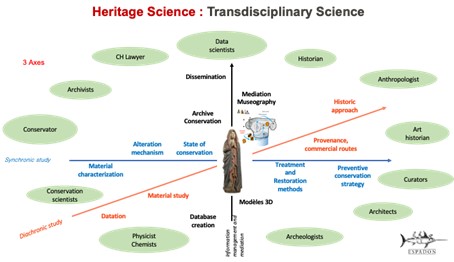
(Figure 1 : Proposition for an object-based conceptual scheme of Heritage Science (© Vincent Detalle, Romain Thomas & consortium ESPADON)
The ESPADON project (2021-2028) is funded[1] in the framework of Agence Nationale de la Recherche PIA3 (Projets d’investissement d’avenir[2]) launched by the French Ministry of Research. It aims to enrich the developing interdisciplinary domain coined as ‘Heritage Science’. Its reference institution is the Fondation des Sciences du Patrimoine (FSP), which for a decade has brought together a large number of French cultural institutions and the best research laboratories dedicated to the study and conservation of tangible heritage. Over the same period, European States and Heritage institutions have embarked on a major digital transformation. While the objective of facilitating the use of resources on a European scale in a multicultural and multilingual context has largely been achieved, the digital archiving of research and the dematerialization of cultural heritage must be constantly revisited due to new technological developments, new paradigms, and new economic models.
[1] 8,4 M€.
[2] 21-ESRE-0050.
Heritage Science issues and actors may be described using an object-based conceptual scheme (Figure 1). The main questions revolve around three axes:
- Issues relative to the synchronic study of the object, i.e. the object considered in its present state: today-materials characterization of the object and all conservation issues;
- Diachronic research about the object, i.e. the history of the object at different scales (microscopic to macroscopic), and from its creation to today;
- Management of data related to the object, curation and dissemination issues.
A diversity of actors, be they academics or professionals, be they individual or institutional, contribute to these issues and may interact with each other. As far as academics are concerned, and without being exhaustive, these are anthropologists, archaeologists, art historians, data scientists, historians, lawyers (cultural heritage lawyers), physical-chemists, physicists, etc. A number of professionals are involved too, including archivists, conservators, curators, librarians, mediators, and so on. In order to be as inclusive as possible, ESPADON has been built gathering a number of educative and cultural institutions, and research units pertaining to these domains and more.
ESPADON’s first objective is to address an instrumental challenge. The strong evolution experienced in the past decade allows now to enhance the characterization of an Heritage object from localized analysis using sampling of artworks or point analysis techniques, to 2D or 3D analytical approach. Time has gone to ensure its implementation towards Heritage objects. In addition, coupling analytical and structural instrumentation, time has gone too to ensure multi-dimensional, multi-scale and multitemporal capabilities in order to get a multimodal approach. That means to merge heterogeneous data in order to treat it and extract new data and new information that are not visible considering each approach separately.
The informational objective is to increase data processing capabilities to address the challenge of massive data management and storage. ESPADON will then have to offer solutions related to data processing, data storage and data exchange. This is in coherence with the digital transition occurring in the different institutions and ministries at French level. These actions will federate the academic and professional communities in France and will be the opportunity to implement training actions. At European level, the project is in line with the E-RIHS DIGILAB initiative. ESPADON will allow the Heritage Science community to dramatically enhance the access to information, e.g. via data mining. One of the key issues is the interoperability in data creation.
Compared to other research domains, cultural heritage is peculiar due to the variety (in materials, shapes, scale, etc.) of studied objects, and to their unicity. Furthermore, at institutional level, habits are quite diverse too. This makes more challenging (but needy) the aim to collect all kind of information or knowledge generated around a single tangible heritage object. ESPADON will set up a digital ecosystem and model to ensure the representation of and access to this information in one dataspace. In that purpose, we develop the concept of an ‘Augmented Heritage Object’ model. Based on a distributed, interoperable storage architecture, it will not be a mere aggregator, but a new media for Heritage Science.
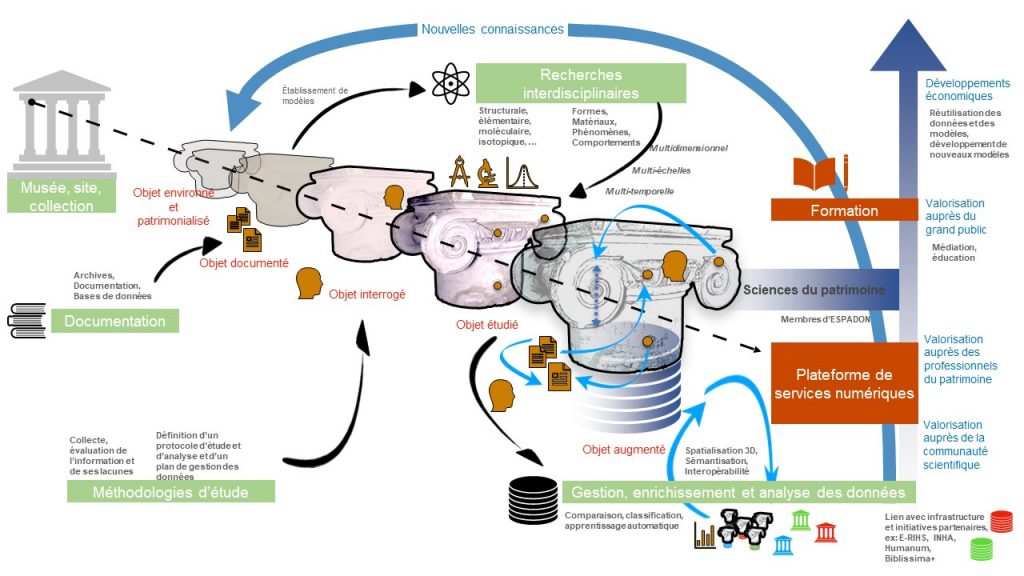
Concept of augmented heritage object (© Livio De Luca, Elsa Marguin-Hamon, Vincent Detalle, Romain Thomas & consortium ESPADON)
‘Heritage objects’ are very diverse, ranging from museum artifacts to historical buildings to archaeological sites. Their patrimonialization implies the existence of a related documentation forged by curation profesionnals, but possibly also archives, scientific reports, historical and art historical studies,… Considering knowledge gaps in this documentation, the object may be enquired via diverse methodologies and be submitted to (interdisciplinary) research concerning e.g. elemental, molecular, structural phenomena, climate change monitoring for the preservation of the object, or the field of humanities, at a different scales.
The challenge will be to find the best way to merge all this heterogeneous data related to the object, and to organize and visualize it. Indeed, ESPADON will offer a digital service platform ensuring digitalization, semantization and interoperability of data. Such a platform will enable e.g. comparison, classification, automatic learning. It will be a new media, shared by the Heritage Science academic community, as well as the professionals. The educative and socio-economic worlds will get access to part of that information, according to the rules of the institutions housing data depositories.

